“I hope it rains every day you’re there.”
My friend says this as I’m leaving for Tofino, and I laugh. I’m not sure what to make of this unlikely send-off.
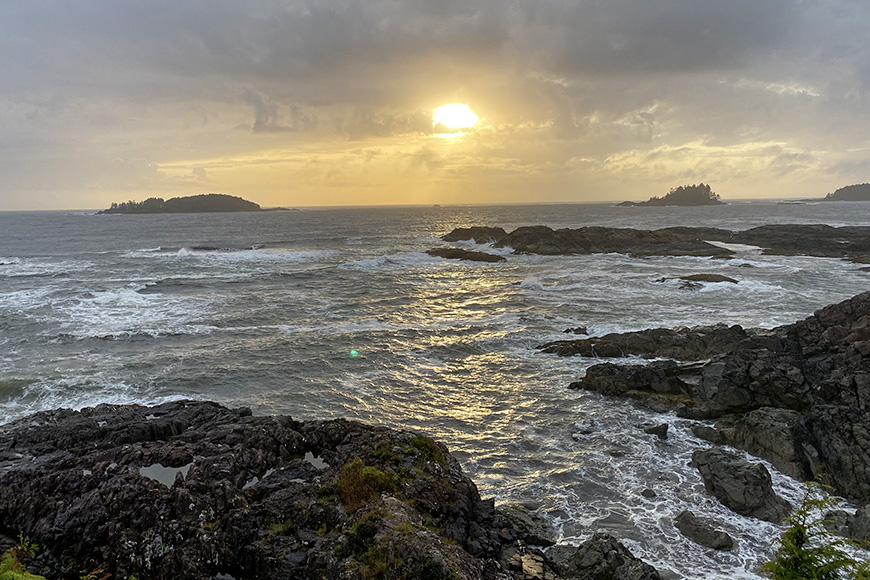
By the time I arrive in Tofino, this hope has manifested into dense rain that falls from a matte gray sky. I step off the plane and look up, curious about this wished-for rain, wondering what makes it the sort of guest you invite on vacation. Cold drops pummel my face, challenging the elasticity of my skin; if I were made of sand, the rain would already be carving channels down my cheeks. I shudder involuntarily as a trail of water slides past my ear and settles on the nape of my neck, sending a snaking sensation up my spine. I nestle back into my hood and wipe my face with my already-wet jacket sleeve.
The rain is steady but not dramatic—there are no thunderclaps, no lightning bolts. The impenetrable rainforest surrounding the small air strip signals that this storm is just another day of the usual water cycle commute, southbound.
I’ve packed strategically, and think I’m prepared for the weather. But I’m not. On the tarmac trudge from the plane to the one-room airport, my water-resistant jacket reaches maximum saturation. Soon, my toes are swimming inside my shoes.
If the West, itself a frontier, has a frontier, this is it. This stretch of Vancouver Island the wildest, wettest, West—where thick forests invent new shades of green with each flicker of sunlight and you’re never far from the roar of waves that have been building strength for 4,500 miles of open Pacific before crashing into Tofino’s rocky shores. On this far left edge of North America, people rush out to meet the rain. In Tofino, home of storm-watching, cold-water surfing, and temperate rainforests, rain is the reason—it’s why people come, and why they stay.
Tofino’s Alchemy of Rain
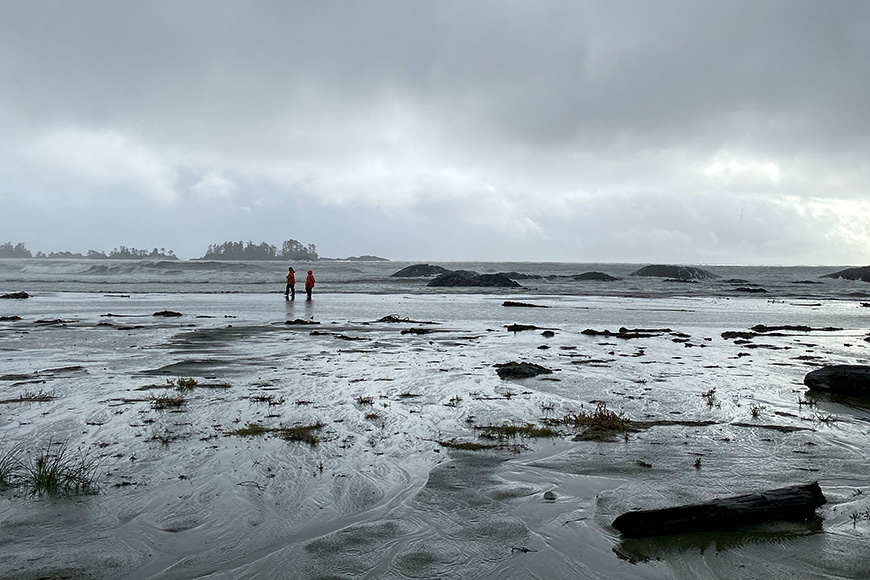
Tofino is the end of the road, and no one comes here accidentally. I am no exception—I’ve been dreaming of this place for years. At home in California, I live within sight of the Pacific, yet my daily glimpse is of an ocean tamed by straits and bays into tentative whitecaps or, at most, assertive lapping. In Tofino, however, the Pacific gets a true running start, and I’m ready to see this wild ocean unleashed.
In most places, storms clear a beach. But this is a place that comes alive with each deluge. Here, there’s an alchemy of rain and big waves. Roiling currents, torrential downpours, and surfers claiming every wave—this is Tofino life. Even non-surfers get in on the action; there’s no surer sight than storm-swept shorelines dotted with beachcombers suited up like New England fishing crews, savoring every minute of big weather.
Storm-Watching from the Inside …
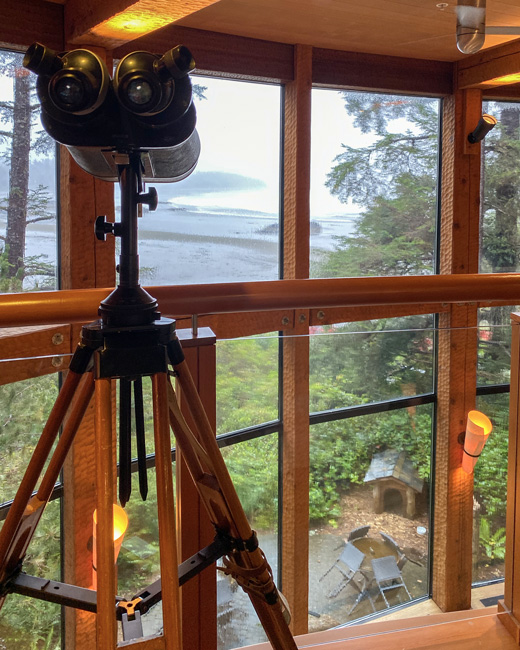
Around here, there’s nowhere more famous for pairing wild and welcoming than the Wickanninish Inn, the hotel that invented storm season. I slosh to the hotel, leaving puddles in my wake, unsure about this adventure as I drip my way through the lobby and up to my room. But after a change of clothes and a warm drink beside a hot fire, I begin to understand the wisdom of my friend’s parting wish.
The Wick, as it’s known locally, sits deep in a forest on the edge of the continent; cradled by trees and holding tight to an outcropping that extends out over the Pacific. Inside, hand-carved wooden columns and windows angled for perfect sea views keep nature close.
Settled inside the warm hotel, I get down to the serious business of storm-watching. I stretch out by the fire and watch surfers take on the storm. I stake out the lobby, which feels more like a living room lined with soft leather chairs and dotted with driftwood tables. I divide my time between watching the waves break around the point and casually inspecting guests—young families, Italian backpackers, retirees, urban sophisticates, honeymooners. I settle onto my sheltered balcony, watching the waves crash into the outcropping just below my room. Not a view goes uninspected, not an overstuffed chair untested.
And yet, the more I watch the rain, the waves, and the dark skies, the more the storm beckons. So instead of putting back on my still-damp jacket—total rookie-wear—I suit up in one of the hotel’s Tofino-grade rubber suits and knee-high galoshes, and set off to discover that the real place to be is not watching the storm, it’s out in the middle of it.
… And Out
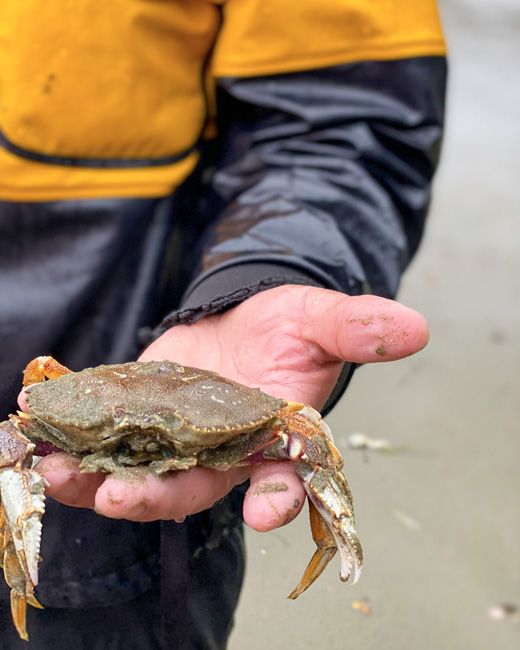
Some beaches are backdrop. Tofino’s take center stage.
Clusters of rocks frame the long stretch of beach, guarding its edges like continental bastions. As soon as I step onto the sand, this place owns my every sense. The wind catches the ocean’s spray and anoints my forehead, my lips, my nose. My cheeks tighten and flush, awake to the tingle of warm and cold pressing in from opposite sides of my skin. The briny tang rushes in on the stiff breeze; I recognize scents that have relied on the same recipe of salt water, seaweed, and sand for millions of years. There is no horizon from here, just towering whitecaps riding a heaving gray sea.
I walk for a while and then realize staying still is the only way to take all this in. I stop, crouch down next to a tangle of brown and orange seaweed knitted slickly together, and watch the ocean. The alternating crash of the waves and the waterfall rush of the retreating water creates a rhythm that slows my thoughts and softens my breathing.
I’ve entirely lost track of time when something, some shift in the breeze, compels me to turn around. I catch sight of the trees at the sand’s border—the trees seem to inhale me, pull me toward it. I walk closer. Here, the tangled branching torrent of the temperate rainforest tumbles down to the edge of the sand.
Standing in this in-between place, I’m struck by the sound of the sea and the rain, these two instruments of Tofino. The symphonic deluge plays the densely forested land-—droplets making each leaf sing a slightly different note—and the crashing waves maintain the baseline for an audience of anyone willing to stop and listen.
I inhale again, and smell the trees as they swap volatile organics for fresh water, flooding the air with Sitka spruce, western hemlock, cedar, and fir. This is a place to feel the earth breathing. I follow a narrow path into the forest, finding my way around the ferns that carpet the forest floor. If I stand still for just a moment too long, I suspect the forest would start to grow up around me, claiming me back.
Hiking the Rainforest
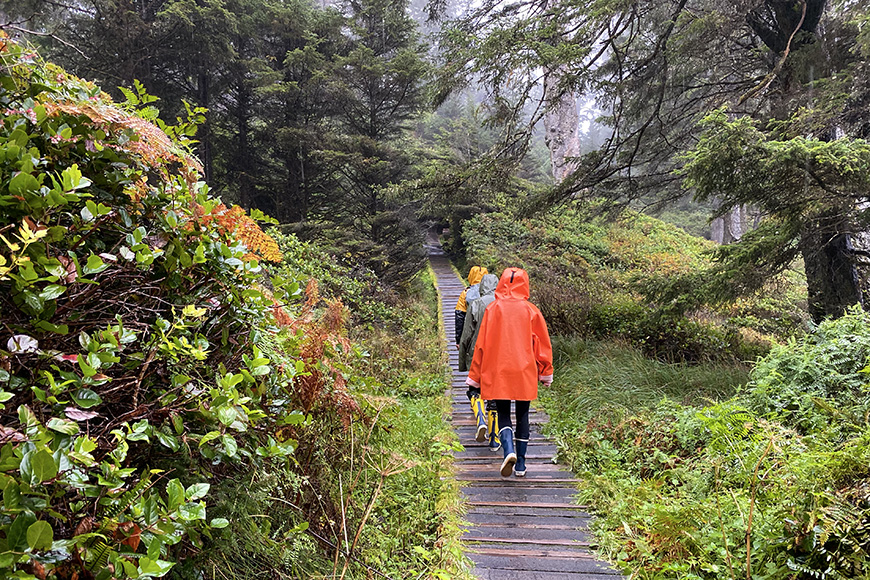
Walking through the temperate rainforest of Pacific Rim National Park in the driving rain, shrouded in waterproof gear, I rediscover something I hadn’t realized was lost: the joy of rain.
I remember playing in the rain as a child and wondering why the adults didn’t join the fun. For a while, they’d hunker under an umbrella and watch us splash and jump, stomp and spin. And then, they’d grow impatient to get back inside, and that would be it. Fun over.
It seemed so strange to me at the time, to act like rain was a hassle instead of the sky inviting you to play. And then it happened: year by year, the delight faded. The thrill of tilting my face up to the rain, arms open to embrace every drop, was replaced by the power of forethought, of being able to imagine the stickiness of a wet jacket, the claustrophobia of soggy socks. Adulthood seemed to leave no room for the ancient pleasure of rain.
And yet, here in the forest, I discover a new form of playing in the rain. The falling drops tickle my face, but the rest of me remains responsibly dry, sheltered within this oversized fisherman’s suit. I wade through pond-caliber puddles and feel the weight of the water pushing up against my boots. I don’t go full Singing in the Rain, but I do stomp, sending out concentric waves and then watching as the water ricochets off the edges of the puddle and bounces back to meet me.
I clear the puddle and walk deeper into the woods. The rain continues, threading its way through the maze of the forest canopy. Drops shatter on leaves around me.
Another puddle. A stream. A waterfall. The rain and the distant percussion of the ocean. I’ve stumbled onto a family reunion, water greeting the earth after a long trip. Feeding the churn of the seas, the green of the trees; creating congregations in creeks and channels—the land transforms the water, and the water transforms the land. And the water, it will continue to transform, through millions of years of precipitation, evaporation, and condensation. But for a moment, it’s home. I realize I’m holding my breath, and I don’t know why. Then I understand, I’m caught up in a wish. I’m wishing for rain.
More from SmarterTravel:
- 10 Best Hidden Hot Springs in North America
- 11 Best Waterproof Backpacks for Travel
- The Ultimate Packing List
Christine Sarkis experienced a version of the Ultimate B.C. package as a guest of the participating hotels and Visit Canada. Follow her on Instagram @postcartography for more advice about making every vacation the best vacation.
We hand-pick everything we recommend and select items through testing and reviews. Some products are sent to us free of charge with no incentive to offer a favorable review. We offer our unbiased opinions and do not accept compensation to review products. All items are in stock and prices are accurate at the time of publication. If you buy something through our links, we may earn a commission.
Related
Top Fares From
Today's Top Travel Deals
Brought to you by ShermansTravel
France: 8-Night Paris, Avignon & Nice...
Infinity Worldwide Vacations
 vacation
$2880+
vacation
$2880+
Poconos: 3 Nts in Garden of...
ResortsAndLodges.com
 hotel
$305+
hotel
$305+
7-Nt Canada & New England Cruise,...
Princess Cruises
 cruise
$839+
cruise
$839+




